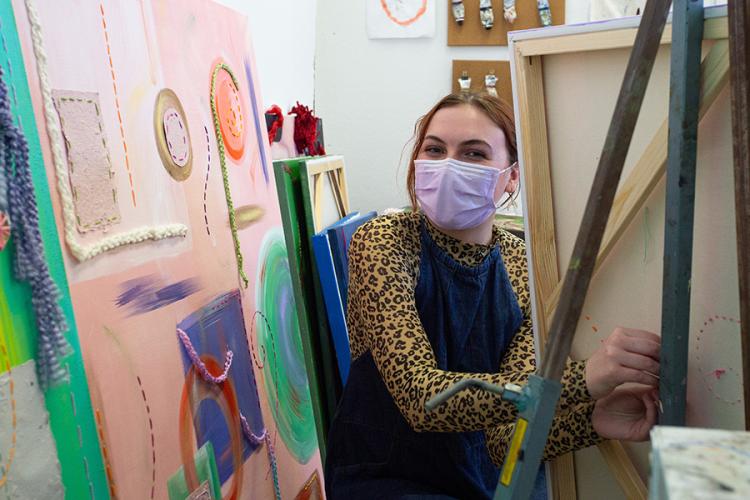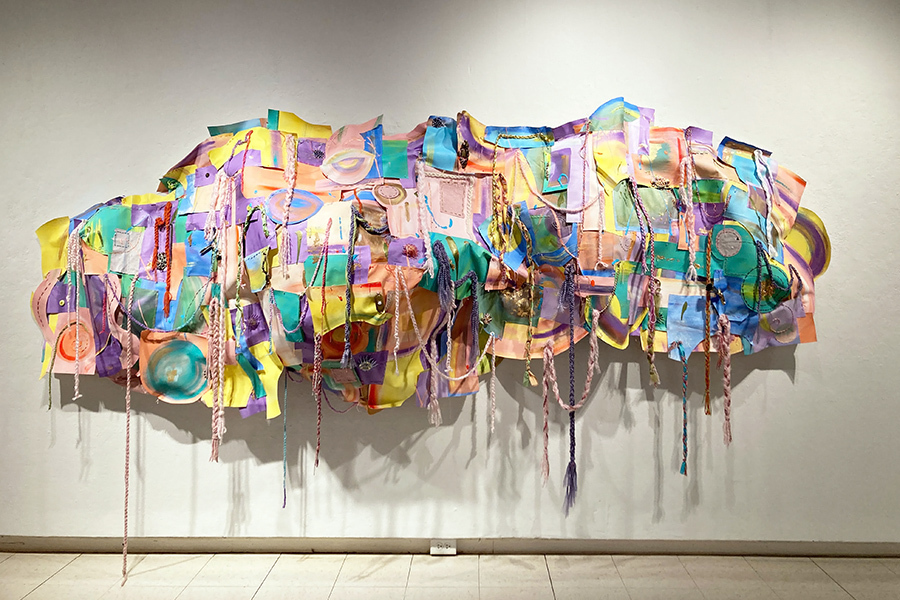

Kelsey Griest has always been drawn to making art, independently and together with others.
Originally from Columbus, she is now finishing a four-year professional degree in Studio Art with a dual concentration in both Painting + Drawing and Art Therapy .
Over the last four years Griest has volunteered with a number of organizations that bring art to underserved communities, including Passion Works Studio , the Beacon School with the Athens County Board of Developmental Disabilities , and currently Art Possible Ohio . She is currently working as a teaching artist at Ewing School in Marietta, Ohio, working with a range of ages as young as pre-K with various developmental disabilities.
“I didn’t initially want to go to college. My 16-year-old brain made a deal that if I had to go to college, I needed to get my nose pierced,” she said with a laugh. A deal she hoped might give her an out.
“When I visited The School of Art + Design I was immediately pulled in” she said. Following an extraordinary service learning course with Passion Works Studios her first year, Griest began to connect the dots and knew she was in the right place.
“I’ve always been interested in therapy, I was always the so called ‘comfort person’ with my friends,” she said.
As a psychology minor, Griest felt that adding the Art Therapy concentration to her degree plan helped to connect her academic studies with her ongoing volunteer work.
The Intro to Art Therapy course “was an eye-opening experience,” recalls Griest. “We did a lot of art therapy on ourselves, and we heard about Valeri’s work with clients.”
Taught by Sarah Valeri , a licensed creative arts therapist based in Brooklyn, New York, and working with students in the School of Art + Design. Her Intro to Art Therapy course sits at the intersection of art and mental health, introducing students to art making as a tool to improve lives.
Valeri, who has delivered art as therapy in a wide range of settings from medical providers to community art projects and educational settings, teaches that the therapeutic strengths of art and art making should be integrated within all healthcare and community settings.
“It does its job simply, by holding a space and time for our shared experiences, but also provides openings to a ‘freedom of responsiveness’ that helps us see life in new ways,” Valeri said.
For Griest, creating art with others should be an enjoyable experience with a focus on the process rather than on the outcome of the artwork. In this way she frames the outcome of making the work to the participant’s engagement and impact.
As a B.F.A. Studio Art Painting + Drawing major, Griest is required to produce her own personal thesis within her studio practice, which includes exhibiting her final work.
“My art practice is informed by my experiences teaching, by making art with children in both neuro-typical and neuro-diverse classrooms. When it comes to teaching art to children of all abilities, one of the most important things to facilitate is the use of different media and modalities of making,” Griest said.
Art therapists are master's level professionals who hold a degree in art therapy. This is definitely on Griest’s list of goals – but first she plans to gain some additional experience working with a variety of clients and students of all ages, starting this summer.
In 2021, Griest worked at Southampton Fresh Air Home , a summer camp for kids with physical disabilities, as a counselor. She made such a positive impression with the Southampton camp directors that she has landed a full-time position as the activities director this summer.
“When she is with the kids they are getting all of her. She is present, she is genuine and she is happy. And that is who she has always been with us, and the campers here,” said David Billingham, camp director at Southampton.
“I’m really excited about what she’ll bring to our program [this summer]. She’ll be overseeing all the camp activities, including our art studio, and it’s going to be a challenge,” Billingham said. “But if she can infuse the same passion, and sense of self, into the program I know it will be well received.”
Griest characterizes her time in the classroom as free flowing and playful, a setting where she encourages students to adjust to their materials. A sensory experience, this process helps students get to know textures, textiles and objects, and students are encouraged to embrace adaptability and looseness in their making, she says.
“I want to help others to make art.” Griest said. To do this well, she added, “You also have to make space for yourself. You need to do what you feel. With art therapy you’re doing art to enjoy the process, to help connect with yourself or somebody else.”

